Day 1 – A Private Tour of Our National Capitol Building
Since our conference takes place on a Thursday, Friday, Saturday, my colleagues and I decided to take advantage of exploring Washington D.C. and fly into town a day early. Through the conference app we were able to connect with teachers around the country and a teacher from Nebraska was kind enough to invite us a guided tour of the U.S. Capitol Building that he scheduled with Nebraska senator Deb Fischer.
As a teacher, history is one of my favorite subjects and with this being only my second time ever in Washington D.C. (the first being only a month earlier), I was so excited and so grateful to take advantage of this once in a lifetime opportunity. Our plane glided to a stop at Reagan international airport and we were off and running, first heading to drop off our luggage at our hotel and then onto our capitol tour!

Our tour began outside of Senator Deb Fischer’s Senate office in the Russell Senate building. This building itself is extremely interesting in terms of architecture as it is three stories above ground on the Constitution Avenue side of the building, but is five stories above ground on the side of the building that faces C street. While the outside of the building may be very plain the inside is beautiful. It is filled with Corinthian columns, marble staircases and each senator’s office contains a fireplace and a window that faces either onto the street or into the inner courtyard. Like most buildings in Washington this building has a rich history as both the sinking of the Titanic and Watergate were investigated within the caucus walls of this building. The Senate was currently in session when we met for our tour so a student from the University of Nebraska currently interning served as our tour guide. Immediately, I noticed that we were not walking out the doors that we used to come into the Russell Building, instead we were walking down stairs. Our tour guide informed us that since the senators need to travel frequently between their offices, committee rooms and the Senate floor a tunnel was constructed to connect the office building to the Capitol. After going through a quick security check we hopped on mini open-air train cars that drove us directly to the Capitol – no waiting in line for tour tickets!

Upon entering the Capitol our first stop was inside of Emancipation Hall. Here we learned that each state has two statues that they have chosen to represent their state. These statues are donated by individual states and represent the diversity of the country and the contributions made by the citizens of those states. These statues are not permanent however, if a state wishes to change the statue in the U.S. Capitol they can at any time and the original statue is typically sent to be displayed in the state Capitol building. The Statue of Freedom is really the focal point within Emancipation Hall. While the bronze Statue of Freedom sits atop the Capitol Dome, this model stands tall at nineteen and a half feet in the center of the room!
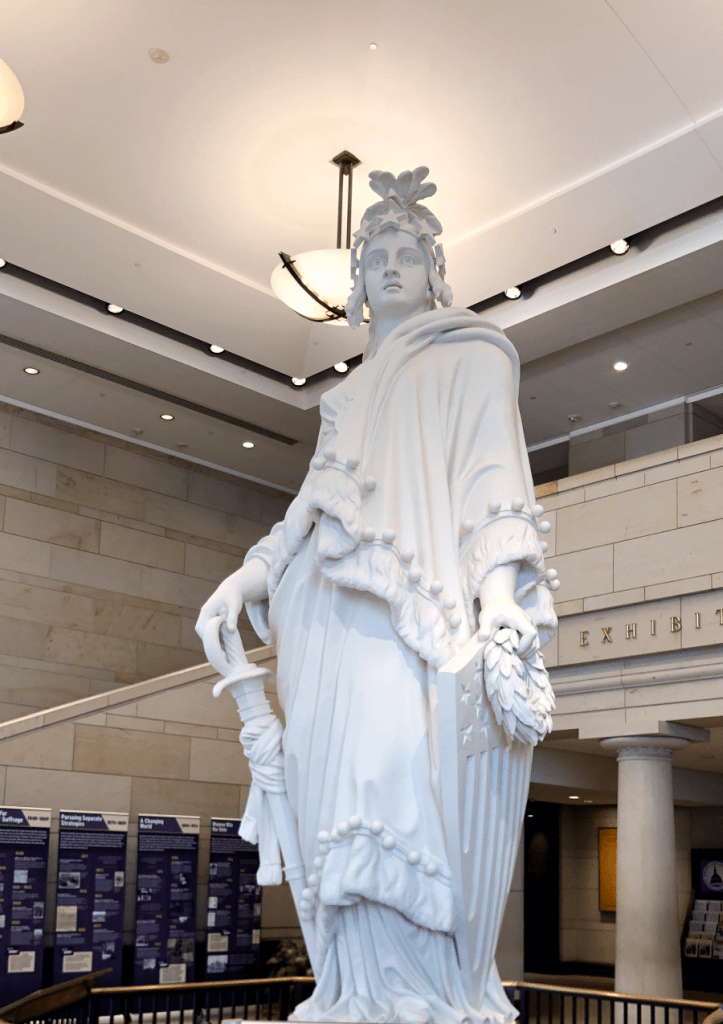
Next, we headed to see the original cornerstone of the Capitol, which was laid by George Washington in 1793. A plaque now stands above this stone to commemorate not only the location of the stone, but the fact that this area survived the fire that nearly destroyed the Capitol.

Our next stop was the Old Supreme Court Chamber, which was the first room constructed for the U.S Supreme court and was used by the Court until 1860! Before entering the room we noticed that coat hooks still hung with the names of the Supreme Court justices that served when the room discontinued service in 1860.
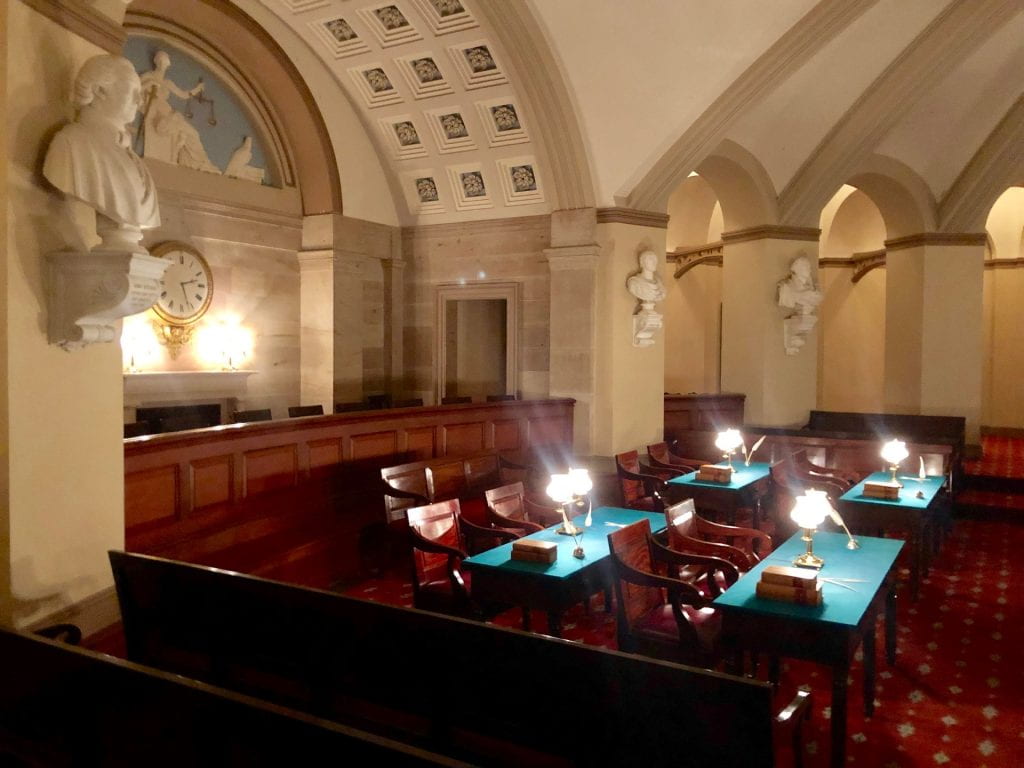
Inside the room were spectacular vaulted ceilings. The room was very dim, however, it gives visitors an insight into what the court hearings would have been like during the nineteenth century prior to electricity. I just imagined how kerosene lamps and cigar smoke must have filled the room during cases such as Dred Scott. When you tour this room make sure to check out the nine Supreme Court justice desks, seven of which are originally from the 19th century, as well as the various chairs behind each desk. Each judge had the chance to pick out the style of chair he preferred at the time.

Next, we meandered our way into the Capitol Crypt. The Crypt is located in the center of the building and was completed in 1827. In the center of the Cript our tour guide pointed out the star on the floor. This star represents the point from which all of the streets in Washington are laid out and numbered. Several of our group members laughed as we discussed this might be the core reason why driving in Washington D.C. can be a nightmare at times. Against the Crypt walls are 13 statues representing each of the original thirteen colonies. With the name “the Crypt” several of our group members wondered if anyone had actually been buried inside. From our guide we learned that the original plan was for Washington to be buried at the Capitol after his death and his statue to be placed inside the Crypt, however, Martha Washington completely disagreed with this plan and Washington’s body remained at Mt. Vernon.

After walking up stairs our next point of interest was the famous U.S. Capitol Rotunda. Upon entering the Rotunda my eyes couldn’t help but immediately stare up at the magnificent dome. From our guide we learned the dome is 96 feet in diameter and 180 feet tall and is located in the center of the Capitol. This room is one of the most important rooms in the Capitol in regards to government related ceremonies. Many notable individuals have lay in state here including Abraham Lincoln, General John A. Logan (a civil war general from my hometown) and John F. Kennedy.
The Rotunda is comprised of breathtaking pieces of artwork. The walls of the Rotunda holds eight historic paintings, four scenes are from the Revolutionary War period and four scenes are from the early exploration.

Above the paintings visitors will find a 360 degree frieze painting. This band starts with the discovery of the Americas by Christopher Columbus and concludes with the discovery of gold in California. We learned that when the original frieze was completed in 1889, nearly thirty feet around the Rotunda still remained to be painted. Nearly five decades later new historical scenes were added to feature the Civil War, the Spanish-American War and the accomplishments of the Wright Brothers.
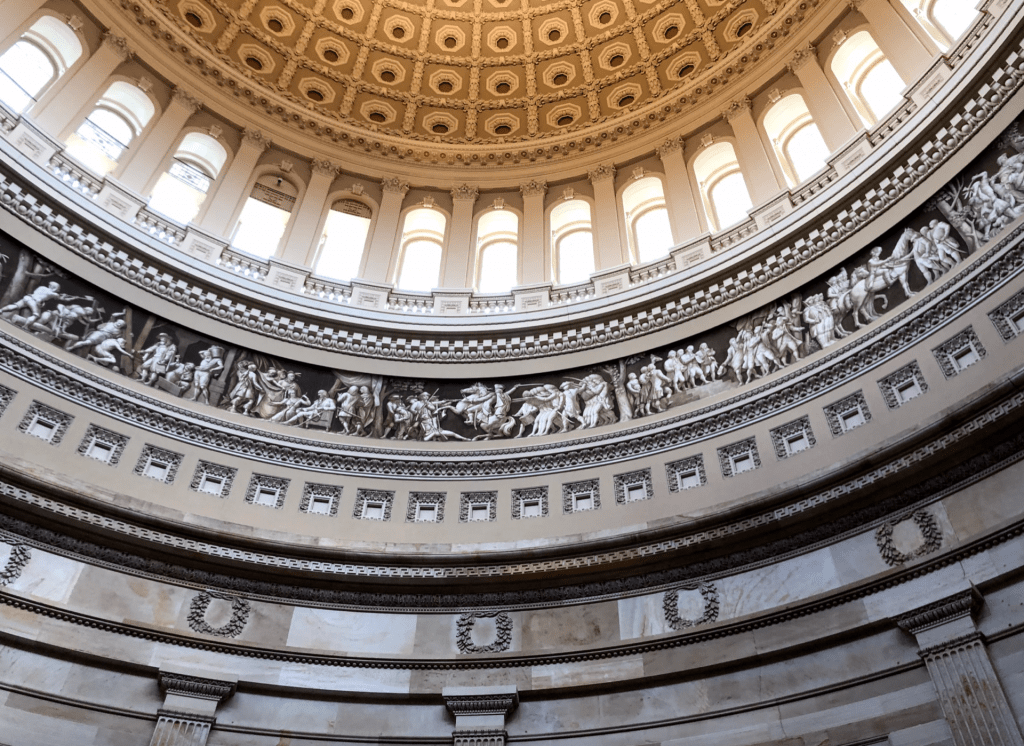
If you are able to explore the Rotunda don’t forget to check out the Apotheosis at the top of the dome. Our guide explained that this painting depicts George Washington surrounded by the one lady representing Liberty and the other woman representing Victory/Fame. Thirteen maidens surround George Washington each representing the thirteen colonies. What I found especially interesting was that the women who represent southern states are painted to look away from George to reflect how these states turned their back on the Union during the Civil War. The Rotunda is a room that is absolutely breathtaking and one can spend a significant time here exploring and analyzing the symbolism within the various art pieces.

After leaving the Rotunda we were led into the National Statuary Hall. This room was originally built to be the chamber for the House of Representatives. However, the smooth curved ceiling presented a challenge as the large amount of echoes made it extremely difficult to complete daily work. Another guide even demonstrated how powerful the acoustics worked, as he stood on one side of the busy hall and we standing on the opposite side could clearly hear him – even though there were many people entering and exiting the hallway, it was shocking! Unable to fix the problem, an entire new chamber was designed and the House moved to their current location. At the beginning of our tour, our guide explained that each state contributes two statues of prominent citizens to display in the Capitol and this is the primary location where these statues are located at.
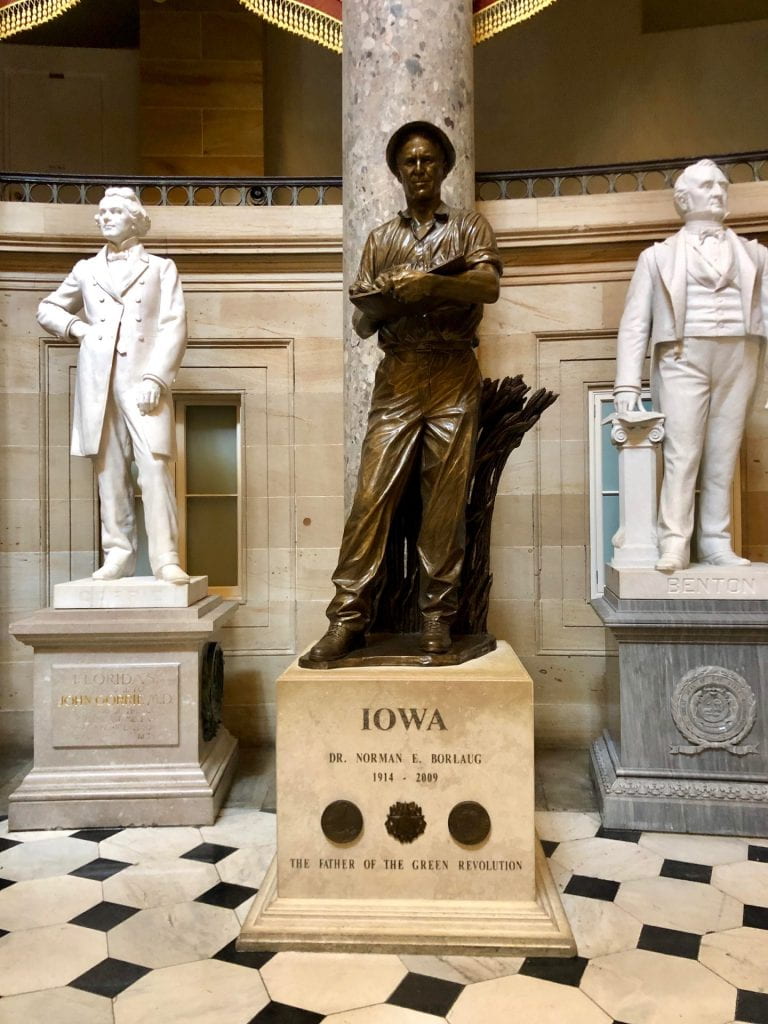

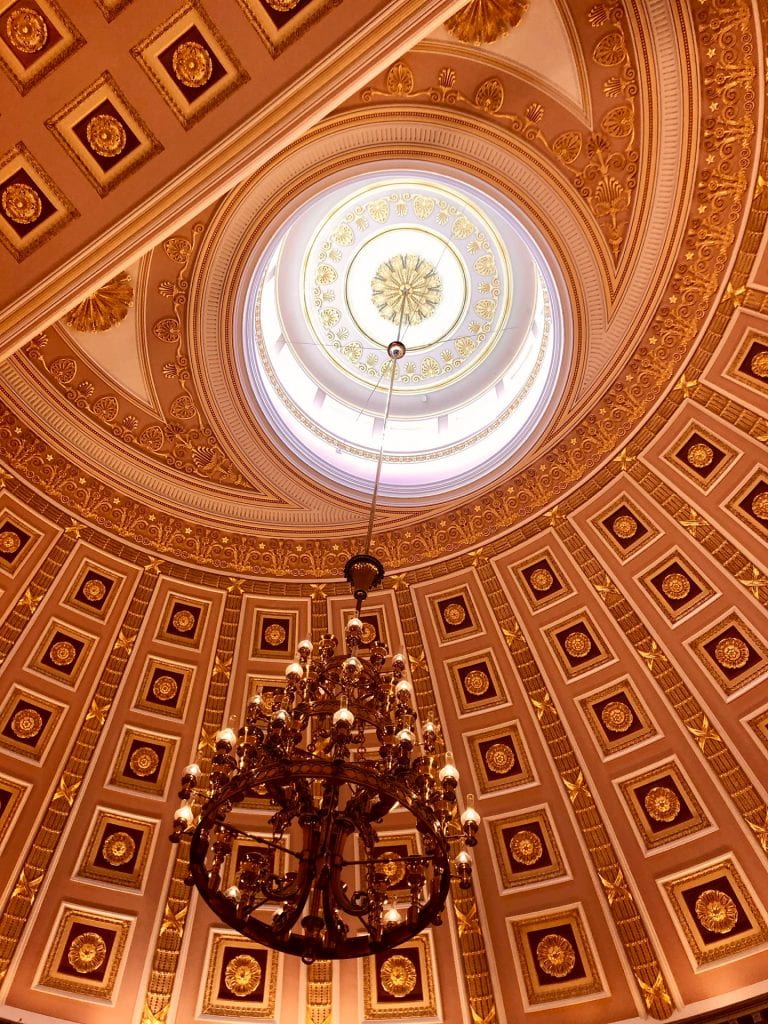
Ending our tour we walked back into the Rotunda and past the two statues of Ronald Regan and Dwight D. Eisenhower, to the side elevator entrance. Prior to stepping onto the elevator our guide explained the memorial plaque on the wall recognizes the individuals of flight 93, which crashed into the field in Pennsylvania on September 11th, 2001. This plaque commemorates the heroes who fought back on that day and sacrificed their own lives to save lives inside of the U.S. Capitol building. Taking a moment to reflect on this brave act reminded me that freedom isn’t free and that many Americans have sacrificed their lives since the creation of this country so that individuals like myself, my family and my students can enjoy the liberties set forth by our founding fathers.
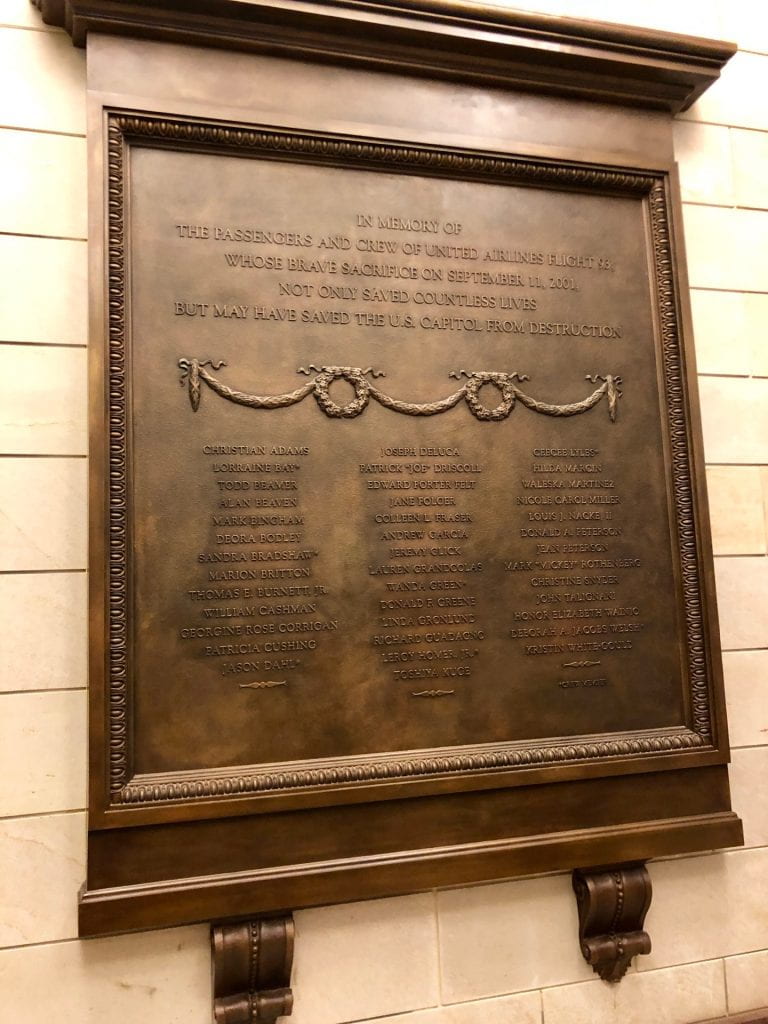
At the conclusion of our tour we were also given passes to observe a current session taking place in the U.S Senate. This Senate chamber has been used since 1859 and is two stories, with the first story hosting the individual desks of the 100 senators and the second floor holding the visitor’s gallery which overlooks the chamber. During our session, we were able to observe the confirmation of Brian C. Buescher of Nebraska to be the United States District Judge of Nebraska. If you are interested in attending a Senate and House session they are open to visitors when the legislative body is in session. However, the gallery tours are not part of the U.S. Capitol tours, therefore you will need to obtain a pass prior to getting in line for the gallery. You can contact your senator or representative if you would like to receive a pass to attend a legislative session. Cell phones, smart watches and any kind of camera or recording device is not allowed inside the chambers so make sure you check out all technology at the security desk prior to entering!
For more information on the U.S Capitol Building or to get tickets for a tour check out: https://www.visitthecapitol.gov